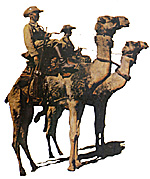 When we talk of camel riders, we think of Arabs the French or British and sometimes of Italians in the colonial past.
When we talk of camel riders, we think of Arabs the French or British and sometimes of Italians in the colonial past.
During his Egyptian campaign, Napoleon mounted some of his soldiers on camels and throughout the last century, and even into this century, colonial powers used camel mounted soldiers in the desert areas of Africa and the Middle East.
In 1880 Germany was the last country to join the other European powers in the colonial conquest. Their share of Africa was on the East coast, Tanganyika or German East Africa and on the West coast, Togo, Cameroons and German South West Africa.
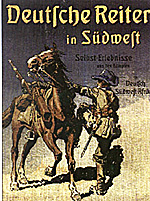 In this latter colony, now called Namibia, the German Colonial Company, in the early days, employed a sort of private army of ten soldiers commanded by an officer as South Africa was a rather turbulent area where a number of rivalling tribes regularly clashed with each other.
When in 1889 the first problems arose about pasture land and water sources between white settlers and local tribes, it was decided to send a reinforcement of another twenty soldiers under the command of Captain von Francois.
In this latter colony, now called Namibia, the German Colonial Company, in the early days, employed a sort of private army of ten soldiers commanded by an officer as South Africa was a rather turbulent area where a number of rivalling tribes regularly clashed with each other.
When in 1889 the first problems arose about pasture land and water sources between white settlers and local tribes, it was decided to send a reinforcement of another twenty soldiers under the command of Captain von Francois.
This small contingent embarked on the British freighter 'Clan Gordon' bound for Walvis Bay. While mining in Teneriffa, von Francois noticed camels imported from the African mainland. An idea struck his mind that these animals might be useful in the new colony, so he bought a few camels and loaded them on board. (The Hereros, a South West African tribe named every year after an important event in that year, so 1889 became 'the year of the camel'. When the German government imported another 20 camels from the Sudan in 1899, that year was named 'the year of the many camels'.)
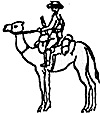 Useful they were, especially in the and areas of the Namib and Kalahari deserts, which formed a large part of the colony. Riding on camels in those early days, according to period photographs, was in the Arab fashion, the rider's legs crossed round the front pommel of the camel saddle.
Useful they were, especially in the and areas of the Namib and Kalahari deserts, which formed a large part of the colony. Riding on camels in those early days, according to period photographs, was in the Arab fashion, the rider's legs crossed round the front pommel of the camel saddle.
The unrest under the native tribes increased as more German and Boer settlers arrived in the colony. Between 1894 and 1904 the armed police force, called 'Schutztruppe' was enlarged up to 700 men mounted infantry.
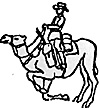 When in 1904 the Herero tribes rose massively against colonial rule, this comparatively small unit was quickly reinforced to 20,000. Within one year the Hereros were defeated
and three quarters of the tribe was wiped out.
When in 1904 the Herero tribes rose massively against colonial rule, this comparatively small unit was quickly reinforced to 20,000. Within one year the Hereros were defeated
and three quarters of the tribe was wiped out.
Camels did not play a role in this bloody episode, except after the decisive battle of Waterberg, when camel patrols were looking for fugitive Hereros in the Sandfeld of the northern Kalahari.
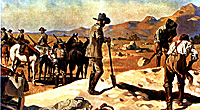 No Peace
No Peace
There was no peace for the Germans however, for as soon as the Herero war was over, the Hottentot tribes in the South of the colony rose against the German government. Now the need for more camels became urgent, as in the Southern part of the colony a railway line had not yet been constructed and all transport was by ox wagons only. At a distance of 160 kilometres through the waterless Namib desert the loss of draught oxen was tremendous and due to the prevailing rinderpest these animals were hard to replace.
In order to transport the army supplies from Luderitz Bay to Keetmanshoop, and to protect the transports by mounted soldiers, General von Trotha (the Commander in Chief) decided to order a great number of camels to solve his transport problems. This decision can well be described as the birth of the camel corps.
The famous Karl Hagenbeck, the biggest animal trader in Germany, received the order to supply 2,000 camels, 1,000 saddles and a number of Arab camel drivers as soon as possible. This large operation is described by Hagenbeck in his book 'Of Animals and Men', of which here is a short version:
 As soon as the order is received, Hagenbeck cables his animal buyers on the East Coast of
Africa to buy camels and bring them to the nearest harbour. He charters five freight steamers for the transport. In Germany, he arranges the necessary food and medical supplies for the camels and further commissions three German firms to produce one thousand camel saddles,
for delivery within a fortnight. Although almost unbelievable, everything is ready in time for
shipment. A couple of weeks later on the January 3 1906 the first ship of five, 'Marie Menzel' leaves Hamburg for Port Said. Here, Lorenz, Hagenbeck's son, is waiting with 76 camels. It appears not so easy to buy suitable animals, especially since useful ones are rare. This problem is due to recent campaigns of the British and Italians in Sudan and Abyssinia where approximately 100,000 camels were lost.
As soon as the order is received, Hagenbeck cables his animal buyers on the East Coast of
Africa to buy camels and bring them to the nearest harbour. He charters five freight steamers for the transport. In Germany, he arranges the necessary food and medical supplies for the camels and further commissions three German firms to produce one thousand camel saddles,
for delivery within a fortnight. Although almost unbelievable, everything is ready in time for
shipment. A couple of weeks later on the January 3 1906 the first ship of five, 'Marie Menzel' leaves Hamburg for Port Said. Here, Lorenz, Hagenbeck's son, is waiting with 76 camels. It appears not so easy to buy suitable animals, especially since useful ones are rare. This problem is due to recent campaigns of the British and Italians in Sudan and Abyssinia where approximately 100,000 camels were lost.
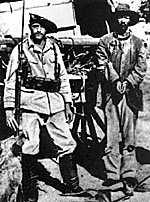 Hagenbeck's animal buyers are not so easily beaten and the organisation has a good reputation with Arabs and Somalis alike. Sailing along the East African coast from port to port the Marie Menzel loads camels everywhere. As finally 403 animals and 60 drivers are on board, the ship steams round the Cape of Good Hope to Swakopmund in German South West Africa.
Hagenbeck's animal buyers are not so easily beaten and the organisation has a good reputation with Arabs and Somalis alike. Sailing along the East African coast from port to port the Marie Menzel loads camels everywhere. As finally 403 animals and 60 drivers are on board, the ship steams round the Cape of Good Hope to Swakopmund in German South West Africa.
As Swakopmund has no harbour and a pier has not yet been constructed, the ship anchors outside and the camels are loaded in lighters, which are pulled ashore by cable winches through whirling breakers onto the beach to be unloaded. The camel drivers who will have the task of instructing the riders of the Schutztruppe how to work with camels are not easy to enroll either. The wildest rumours about their fate are going round from slave labour in goldmines to a life amongst cannibals - but Hagenbeck's men are able to recruit sufficient drivers, and with the four other ships, the rest of the 2000 camels are unloaded at Swakopmund and Luderitz Bay.
 The last batch has arrived in the colony 192 days after having received the order, a remarkable feat and a logistic miracle.
The last batch has arrived in the colony 192 days after having received the order, a remarkable feat and a logistic miracle.
Although the greater battles of the Hottentot war were practically over now, guerrilla activities kept the Germans occupied for the next couple of years until in 1908 peace was eventually restored.
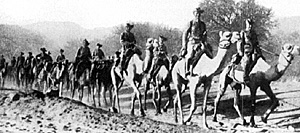 Lt Col von Erckert (right) , with 700 camels and riders, formed a number of camel mounted companies to oppress the last nest of guerrilla resistance. Von Erckert, the father of the German camel corps was killed in action during the last episode of the Hottentot rebellion.
Lt Col von Erckert (right) , with 700 camels and riders, formed a number of camel mounted companies to oppress the last nest of guerrilla resistance. Von Erckert, the father of the German camel corps was killed in action during the last episode of the Hottentot rebellion.
Law and order being restored, most of the troops were repatriated, only about 4,000 remained in the colony. Of the four camel companies, three were disbanded only the 7th company remained and was stationed in the North of the colony. With the outbreak of the First World War, the Republic of South Africa invaded German South West from the South, so the 7th camel company took no part in the actions.
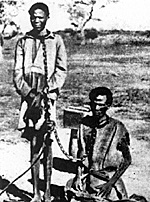 After the German surrender in 1915, some of the camels were used by the South African police, until they were replaced by motor cars. The remainder of the camels were turned out in the Kalahari game reserve to run wild.
After the German surrender in 1915, some of the camels were used by the South African police, until they were replaced by motor cars. The remainder of the camels were turned out in the Kalahari game reserve to run wild.
On the subject of the German Colonial camel corps, the Dutch National Tin Figure Museum, in co operation with the Red Box Toy Soldier Company, have produced a mounted camel rider to the German camel corps in GSWA painted in toy style and in toy-figure scale 1: 32 (54mm), the first subject in a series. This figure can also be obtained unpainted from the Museum. Sales in Great Britain are by The Red Box Toy Soldier Company, and on the Continent of Europe through the National Tin Figure Museum in Ommen, Netherlands.
PICTURE CREDITS
Cover and reverse of German Imperialism in Africa by Helmuth Stoecker. Line art by Peter Dennis from Battle in Africa by Howard Whitehouse. Cover of Urgent Imperial Service by Gerald L'ange.
This article first appeared in Toy Soldier 13.
More German Camel Corps
Back to Age of Empires Issue 14 Table of Contents
Back to Age of Empires List of Issues
Back to MagWeb Master List of Magazines
© Copyright 1998 by Partizan Press.
This article appears in MagWeb (Magazine Web) on the Internet World Wide Web.
Other military history articles and gaming articles are available at http://www.magweb.com